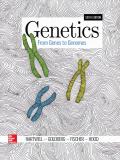
Concept explainers
a.
To determine:
The appearance of chromosome 1 after FISH having genotypes Del1/Del2.
Introduction:
Human chromosome 1 is a large metacentric chromosome. Some of the telomeric regions on the chromosome were barcoded by multicolor banding. Fluorescence In situ Hybridization technique (FISH) is used to label the DNA probes.
b.
To determine:
The appearance of chromosome 1 after FISH having genotypes Del1/+.
Introduction:
Multicolor banding is done towards the telomeric end of chromosome 1 using different fluorescent dyes. This technique of banding is called FISH. The banding pattern is unique for different genotypes.
c.
To determine:
The appearance of chromosome 1 after FISH having genotypes Inv1/+.
Introduction:
Inversion refers to a type of chromosomal mutation in which a segment of a chromosome gets reversed from one end to the other. Inversion is of two types, paracentric and pericentric inversion. Pericentric inversion includes the centromere, whereas; paracentric inversion does not involve centromere.
d.
To determine:
The appearance of chromosome 1 after FISH having genotypes Inv2/+.
Introduction:
Inversion can be classified into two types, paracentric and pericentric inversion. Pericentric inversion includes the centromere, whereas; paracentric inversion does not involve centromere.
e.
To determine:
The appearance of chromosome 1 after FISH having genotypes Inv2/Inv2.
Introduction:
The technique of banding the chromosomal region by using different fluorescent dyes is called FISH. The banding pattern is unique for different genotypes.
Want to see the full answer?
Check out a sample textbook solution
Chapter 13 Solutions
EBK GENETICS: FROM GENES TO GENOMES
- please fill in missing parts , thank youarrow_forwardplease draw in the answers, thank youarrow_forwarda. On this first grid, assume that the DNA and RNA templates are read left to right. DNA DNA mRNA codon tRNA anticodon polypeptide _strand strand C с A T G A U G C A TRP b. Now do this AGAIN assuming that the DNA and RNA templates are read right to left. DNA DNA strand strand C mRNA codon tRNA anticodon polypeptide 0 A T G A U G с A TRParrow_forward
- Please identify the curve shown below. What does this curve represent? Please identify A, B, C, D, and E (the orange oval). What is occurring in these regions?arrow_forwardPlease identify the test shown here. 1) What is the test? 2) What does the test indicate? How is it performed? What is CX? 3) Why might the test be performed in a clinical setting? GEN CZ CX CPZ PTZ CACarrow_forwardDetermine how much ATP would a cell produce when using fermentation of a 50 mM glucose solution?arrow_forward
- Determine how much ATP would a cell produce when using aerobic respiration of a 7 mM glucose solution?arrow_forwardDetermine how much ATP would a cell produce when using aerobic respiration to degrade one small protein molecule into 12 molecules of malic acid, how many ATP would that cell make? Malic acid is an intermediate in the Krebs cycle. Assume there is no other carbon source and no acetyl-CoA.arrow_forwardIdentify each of the major endocrine glandsarrow_forward
 Biology Today and Tomorrow without Physiology (Mi...BiologyISBN:9781305117396Author:Cecie Starr, Christine Evers, Lisa StarrPublisher:Cengage Learning
Biology Today and Tomorrow without Physiology (Mi...BiologyISBN:9781305117396Author:Cecie Starr, Christine Evers, Lisa StarrPublisher:Cengage Learning Biology: The Dynamic Science (MindTap Course List)BiologyISBN:9781305389892Author:Peter J. Russell, Paul E. Hertz, Beverly McMillanPublisher:Cengage Learning
Biology: The Dynamic Science (MindTap Course List)BiologyISBN:9781305389892Author:Peter J. Russell, Paul E. Hertz, Beverly McMillanPublisher:Cengage Learning Concepts of BiologyBiologyISBN:9781938168116Author:Samantha Fowler, Rebecca Roush, James WisePublisher:OpenStax College
Concepts of BiologyBiologyISBN:9781938168116Author:Samantha Fowler, Rebecca Roush, James WisePublisher:OpenStax College Human Heredity: Principles and Issues (MindTap Co...BiologyISBN:9781305251052Author:Michael CummingsPublisher:Cengage Learning
Human Heredity: Principles and Issues (MindTap Co...BiologyISBN:9781305251052Author:Michael CummingsPublisher:Cengage Learning Biology 2eBiologyISBN:9781947172517Author:Matthew Douglas, Jung Choi, Mary Ann ClarkPublisher:OpenStax
Biology 2eBiologyISBN:9781947172517Author:Matthew Douglas, Jung Choi, Mary Ann ClarkPublisher:OpenStax





